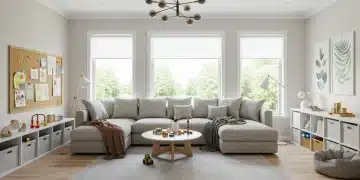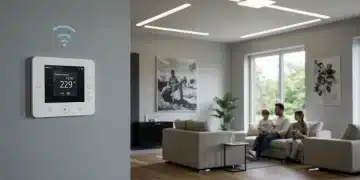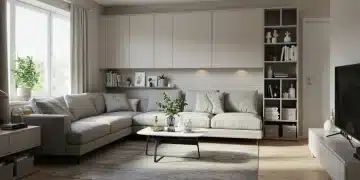Home Lighting Guide: Brighten Your Space and Save 10% on Electricity
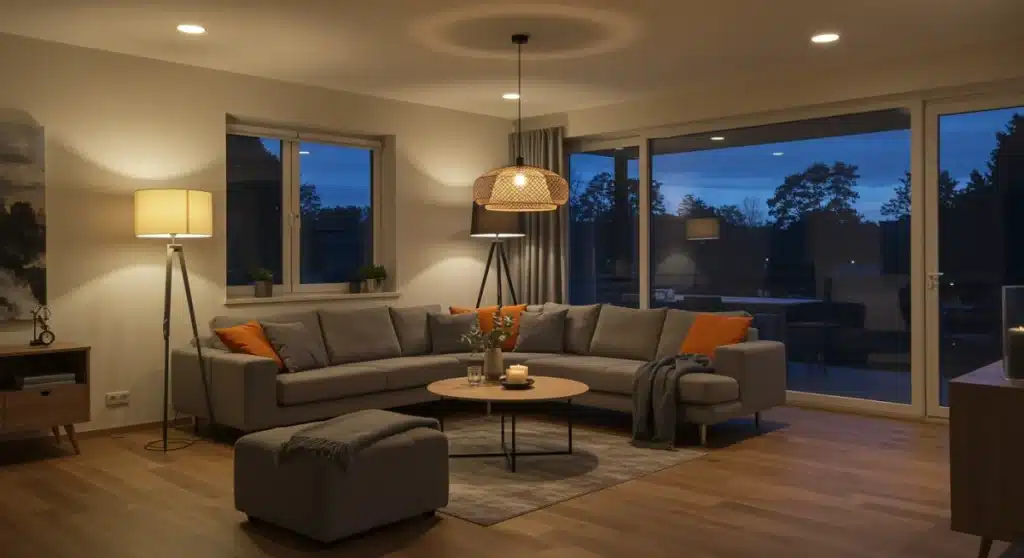
Advertisement
Optimizing your home’s lighting can significantly enhance ambiance, improve functionality, and reduce energy costs, with strategic upgrades potentially saving 10% or more on electricity bills.
Welcome to our comprehensive home lighting guide, where we explore how thoughtful illumination can transform your living spaces, enhance your family’s comfort, and contribute to significant savings on your electricity bill. Beyond mere functionality, lighting is an art form that shapes mood, highlights decor, and defines the character of each room in your home.
Understanding the Basics of Home Lighting Design
Effective home lighting is a delicate balance of aesthetics, functionality, and efficiency. It involves more than just screwing in a light bulb; it’s about creating layers of light that serve different purposes and adapt to various activities throughout the day. A well-designed lighting scheme can make a small room feel spacious, a dark corner inviting, and a busy kitchen highly functional.
Advertisement
The foundation of good lighting design rests on three primary types of lighting: ambient, task, and accent. Each plays a crucial role in creating a layered and dynamic environment that caters to your family’s needs and lifestyle. Understanding these basics is the first step towards a brighter, more energy-efficient home.
Ambient Lighting: The Foundation of Your Space
Ambient lighting provides general illumination, ensuring a space is uniformly bright enough for basic navigation and comfort. This is often the first layer of light installed in any room, serving as the primary source of light. It sets the overall mood and brightness level, impacting how colors appear and how the room feels.
- Recessed lighting: Offers a clean, unobtrusive look, ideal for general illumination in modern homes.
- Ceiling fixtures: Pendants, chandeliers, and flush mounts provide overhead light, often serving as a focal point.
- Track lighting: Versatile for directing light to different areas, useful in kitchens or galleries.
- Natural light: Maximizing daylight is the most energy-efficient ambient lighting, reducing the need for artificial sources.
Integrating natural light with artificial ambient sources is key to a holistic design. Consider window treatments that allow maximum light penetration while offering privacy, and strategically place mirrors to reflect and amplify natural brightness.
Advertisement
Task Lighting: Illuminating Your Activities
Task lighting is focused illumination designed to help you perform specific activities safely and comfortably, such as reading, cooking, working, or applying makeup. Without adequate task lighting, you risk eye strain and reduced productivity. This layer of lighting should be bright enough to prevent shadows and glare, ensuring clarity and comfort.
When selecting task lighting, consider the specific activity and the direction of the light. For instance, a desk lamp should illuminate your work surface without casting shadows from your body or hands. In a kitchen, under-cabinet lighting can brighten countertops for food preparation. The goal is to provide direct, efficient light precisely where it’s needed.
Accent Lighting: Highlighting and Defining
Accent lighting is used to draw attention to specific features, objects, or areas within a room, adding drama and visual interest. It’s the decorative layer that brings personality and style to your home. This type of lighting often uses narrower beams of light to create focal points, enhancing the aesthetic appeal of your decor.
- Wall sconces: Create decorative patterns on walls, highlighting architectural features or artwork.
- Picture lights: Specifically designed to illuminate paintings, photographs, or wall hangings.
- Spotlights: Can be used to emphasize plants, sculptures, or display shelves.
- Uplighting: Creates a sense of height and drama by directing light upwards onto walls or ceilings.
By skillfully layering these three types of lighting, you can create a versatile and inviting atmosphere that adapts to any occasion, from a vibrant family gathering to a quiet evening at home. This strategic approach not only enhances your living experience but also lays the groundwork for significant energy savings.
Embracing Energy-Efficient Lighting for Savings
One of the most impactful ways to save on your electricity bill is by upgrading to energy-efficient lighting. Traditional incandescent bulbs consume a disproportionate amount of energy compared to their light output, converting most of it into heat rather than light. Modern alternatives offer superior efficiency, longevity, and often, better light quality.
The shift towards more sustainable lighting options is not just an environmental imperative; it’s a smart financial decision for every household. By making informed choices, you can reduce your energy consumption by a noticeable margin, potentially saving 10% or more on your monthly electricity expenses without sacrificing brightness or ambiance.
LED Technology: The Future of Home Illumination
Light Emitting Diodes (LEDs) have revolutionized home lighting, becoming the gold standard for energy efficiency. LEDs consume significantly less power than incandescent bulbs, typically 75-80% less, and last 25 times longer. This translates to substantial savings on both your electricity bill and replacement costs over time. Beyond their efficiency, LEDs offer incredible versatility in terms of color temperature, brightness, and design.
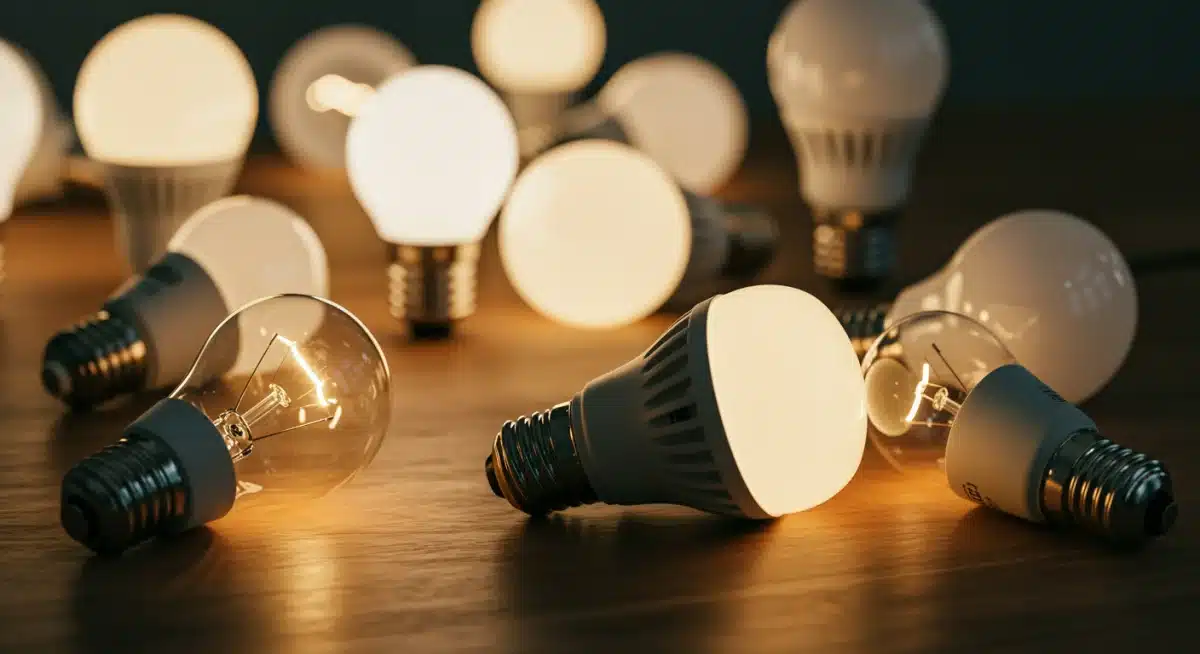
When choosing LEDs, consider their color temperature, measured in Kelvin (K). Lower Kelvin values (2700K-3000K) produce a warm, yellowish light, similar to incandescents, ideal for living rooms and bedrooms. Higher values (4000K-5000K) create a cooler, bluer light, suitable for kitchens, bathrooms, and task-oriented areas. Many LEDs are also dimmable, offering even greater control over ambiance and energy use.
Smart Lighting Systems: Control and Convenience
Smart lighting systems take energy efficiency and convenience to the next level. These systems allow you to control your lights wirelessly via a smartphone app, voice commands, or smart home assistants. Features include scheduling lights to turn on and off, adjusting brightness and color temperature, and even integrating with motion sensors to ensure lights are only on when a room is occupied.
- Scheduling: Automate your lights to mimic occupancy while you’re away or to dim gradually at bedtime.
- Dimming capabilities: Reduce energy consumption while creating the perfect mood for any occasion.
- Motion sensors: Ensure lights in utility rooms, hallways, or closets automatically turn off when not needed.
- Zoned control: Manage individual lights or groups of lights independently, minimizing wasted energy.
Investing in smart lighting can seem like an upfront cost, but the long-term energy savings and enhanced control often outweigh the initial expense. They offer unparalleled flexibility, allowing you to fine-tune your home’s illumination to precisely match your needs and significantly reduce unnecessary power consumption.
Strategic Placement and Layering for Optimal Brightness
The placement of your light fixtures is as crucial as the type of bulbs you choose. Thoughtful placement ensures that each area of your home receives adequate illumination for its intended purpose, preventing dark spots and maximizing comfort. Layering different types of lighting creates depth and flexibility, allowing you to adapt the ambiance to various activities and times of day.
Consider the architecture of your rooms, the furniture layout, and the natural light sources. A well-designed lighting plan integrates all these elements to create a harmonious and energy-efficient environment. Avoid relying on a single overhead fixture, as this often leads to flat, uninspiring illumination and creates harsh shadows.
Living Room: Versatility and Ambiance
The living room is often the heart of the home, used for a variety of activities from relaxing and entertaining to reading and watching TV. Therefore, its lighting scheme needs to be highly versatile. Start with a good ambient base, such as recessed lights or a stylish ceiling fixture, then add task and accent lighting.
- Floor lamps: Provide task lighting for reading nooks and add decorative flair.
- Table lamps: Offer softer, localized light for conversation areas and visual interest.
- Dimmers: Essential for adjusting the mood, from bright and lively for gatherings to soft and intimate for relaxation.
- Wall sconces: Can highlight artwork or architectural features, adding a touch of elegance.
Remember to consider the color temperature of your bulbs. Warmer tones (2700K-3000K) are generally preferred for living rooms to create a cozy and inviting atmosphere. Experiment with different combinations to find what works best for your family’s lifestyle.
Kitchen: Functionality and Brightness
The kitchen is a highly functional space where bright, clear lighting is paramount for safety and efficiency. Task lighting is particularly important here, especially over countertops, the stove, and the sink. Ambient lighting should be sufficient to illuminate the entire room without glare.
Under-cabinet lighting is a game-changer in the kitchen, providing direct light on your work surfaces and eliminating shadows. Pendant lights over an island or breakfast bar can offer both task lighting and a decorative element. Consider using cooler color temperatures (3500K-4000K) in the kitchen, which can enhance visibility and make food preparation easier.
Bedroom: Comfort and Relaxation
Bedrooms require lighting that promotes relaxation and comfort. Soft, warm ambient light is ideal, complemented by task lighting for reading in bed. Dimmers are particularly useful here, allowing you to create a serene environment conducive to sleep or a brighter setting for dressing.
- Bedside lamps: Essential for reading and providing localized light without disturbing a partner.
- Pendant lights: Can replace bedside lamps, freeing up nightstand space and adding modern style.
- Recessed lighting: Provides a clean ambient light that can be dimmed for a calming effect.
- Blackout curtains: While not lighting fixtures, they control natural light, crucial for sleep quality.
Avoid harsh overhead lighting in the bedroom. Focus on creating a soft, layered glow that can be easily adjusted to suit your mood and activities. This approach ensures your bedroom remains a sanctuary of peace and comfort.
Maximizing Natural Light and Utilizing Dimmers
Leveraging natural light is the most cost-effective and environmentally friendly way to illuminate your home. Sunlight not only brightens your interiors but also offers psychological benefits, improving mood and productivity. Incorporating dimmers into your lighting scheme further enhances energy efficiency and provides unparalleled control over your home’s ambiance.
Many homeowners overlook the power of natural light, often resorting to artificial sources when simple adjustments could suffice. By strategically maximizing daylight and integrating dimmers, you can significantly reduce your electricity consumption and create a more dynamic and inviting living space. These practices are fundamental to a truly energy-efficient home lighting guide.
Harnessing Daylight: Design Strategies
Designing your home to maximize natural light involves several key strategies, from window placement to interior finishes. Even in existing homes, there are numerous ways to enhance daylight penetration and reduce reliance on artificial lighting during the day. This not only saves energy but also creates a healthier, more vibrant indoor environment.
- Window treatments: Opt for sheer curtains or blinds that can be easily opened to allow maximum light.
- Mirror placement: Strategically place mirrors opposite windows to reflect and amplify natural light into darker corners.
- Light-colored walls: Pale paint colors and reflective surfaces help bounce light around the room, making it feel brighter and more spacious.
- Open floor plans: Minimize interior walls to allow light to flow freely between rooms, reducing shadowed areas.
Consider the direction of your windows; south-facing windows receive consistent light throughout the day, while east and west-facing windows offer morning and afternoon sun, respectively. North-facing windows provide softer, more consistent light. Understanding these dynamics can help you optimize your window treatments and interior design to make the most of natural illumination.
The Power of Dimmers: Beyond Just Mood
Dimmers are an often-underestimated tool in energy conservation and lighting design. While commonly associated with creating ambiance, dimmers also play a critical role in reducing electricity consumption. Dimming a light by even a small percentage can extend bulb life and significantly cut down on energy use, contributing to your goal of saving 10% on electricity.
Modern dimmers are compatible with most LED bulbs, offering smooth transitions and flicker-free performance. Installing dimmers in frequently used rooms like living rooms, dining rooms, and bedrooms allows you to adjust light levels according to the activity and time of day, ensuring you only use the amount of light truly needed. This flexibility not only saves energy but also adds a layer of sophistication to your home lighting.
Outdoor Lighting: Safety, Security, and Style
Outdoor lighting extends the aesthetics and functionality of your home beyond its walls, enhancing curb appeal, improving safety, and increasing security. Just like indoor lighting, strategic outdoor illumination can be energy-efficient, utilizing modern technology to provide effective light without excessive electricity consumption. It’s an integral part of any comprehensive home lighting guide.
When planning outdoor lighting, consider the various areas around your home: pathways, entryways, architectural features, and landscaping. Each area will have different lighting requirements, balancing the need for visibility with aesthetic appeal. The right outdoor lighting creates an inviting exterior while deterring potential intruders.
Enhancing Curb Appeal and Safety
Well-placed outdoor lights can transform your home’s exterior after dark, highlighting its best features and creating a welcoming glow. Beyond aesthetics, safety is a primary concern. Illuminated pathways and steps prevent trips and falls, especially for family members and guests navigating your property at night.
- Pathway lights: Guide visitors safely along walkways and driveways.
- Step lights: Ensure visibility on stairs and elevation changes.
- Entryway lighting: Brightens your front door, making it easy to find keys and welcoming guests.
- Floodlights: Can be used for security purposes, illuminating large areas with bright light.
Consider solar-powered lights for pathways and garden accents. These fixtures charge during the day and automatically turn on at dusk, offering an energy-free lighting solution. For security, motion-activated lights are highly effective, providing light only when needed and acting as a deterrent.
Security and Energy Efficiency in Outdoor Spaces
Outdoor lighting plays a vital role in home security, deterring intruders by eliminating dark hiding spots. However, constant illumination can be wasteful. The key is to combine strategic placement with energy-efficient technologies and smart controls to maximize security while minimizing energy use.
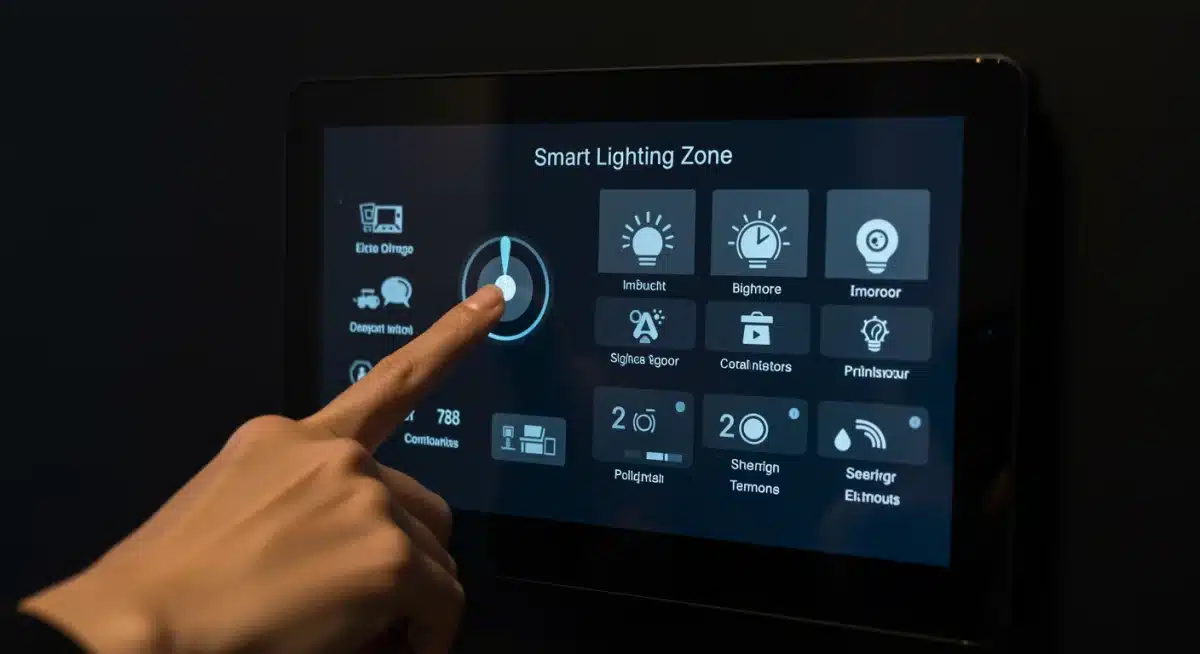
LED landscape lighting uses very little energy and offers a wide range of beam angles and color temperatures, allowing you to highlight specific plants or architectural details. Motion sensors are invaluable for security lighting, activating bright lights only when movement is detected. Furthermore, smart outdoor lighting systems allow you to schedule lights, integrate them with security cameras, and even control them remotely.
By carefully planning your outdoor lighting, you can create a beautiful, safe, and secure environment around your home without racking up high electricity bills. It’s an investment that pays off in both peace of mind and enhanced property value, aligning perfectly with the principles of a comprehensive home lighting guide.
Maintenance and Upgrades for Long-Term Savings
Maintaining your lighting system and making timely upgrades are crucial for ensuring long-term energy efficiency and optimal performance. Even the best lighting design can lose its effectiveness and efficiency if not properly cared for. Regular maintenance not only extends the life of your fixtures and bulbs but also ensures they operate at peak performance, contributing to sustained electricity savings.
Consider your lighting system as an evolving part of your home. As technology advances and your family’s needs change, so too should your lighting. Proactive maintenance and strategic upgrades are key to keeping your home bright, beautiful, and energy-efficient for years to come. This continuous approach is a cornerstone of an effective home lighting guide.
Regular Cleaning and Inspection
Dust and dirt can accumulate on light fixtures and bulbs, significantly reducing their light output. A dusty bulb can emit up to 30% less light than a clean one, forcing you to use higher wattage or more fixtures to achieve the desired brightness. Regular cleaning is a simple yet effective way to maintain optimal light levels and energy efficiency.
- Wipe down fixtures: Clean dust and grime from lampshades, diffusers, and bulb surfaces regularly.
- Check wiring: Periodically inspect visible wiring for any signs of wear or damage, especially in older homes.
- Replace faulty components: Address flickering bulbs or malfunctioning switches promptly to prevent further issues.
- Prune outdoor foliage: Ensure trees and shrubs aren’t blocking outdoor light fixtures, reducing their effectiveness.
A routine cleaning schedule, perhaps coinciding with seasonal home maintenance, can make a significant difference in the perceived brightness and energy consumption of your lighting system. It’s a small effort that yields noticeable benefits in both aesthetics and utility savings.
When to Upgrade: Timely Replacements
Knowing when to upgrade your lighting components is essential for maximizing savings and efficiency. While LEDs boast long lifespans, technology continues to evolve, offering even greater efficiency and features. Replacing older, less efficient bulbs and fixtures is a straightforward way to reduce your carbon footprint and electricity bill.
Consider replacing any remaining incandescent or halogen bulbs with LEDs. The energy savings alone will quickly offset the cost of the new bulbs. If you have older fluorescent fixtures, consider upgrading to LED tube lights, which offer superior light quality and efficiency without requiring a complete fixture overhaul. Additionally, as smart home technology becomes more accessible, upgrading to smart dimmers and switches can provide enhanced control and further energy optimization.
By staying informed about the latest lighting innovations and regularly assessing your home’s lighting needs, you can ensure your system remains at the forefront of energy efficiency. This proactive approach to maintenance and upgrades is a vital component of any comprehensive home lighting guide aimed at brightening your space and saving electricity.
Advanced Techniques for Energy Savings and Comfort
Beyond basic upgrades, several advanced techniques can further enhance your home’s lighting efficiency and overall comfort. These strategies often involve integrating technology and thoughtful design principles to create a truly optimized lighting environment. Embracing these advanced methods can lead to even greater electricity savings and a more intuitive living experience for your family.
Think about how light interacts with your daily routine and how you can make that interaction seamless and efficient. From daylight harvesting to advanced controls, these techniques push the boundaries of what’s possible in modern home illumination, ensuring maximum benefit with minimal energy expenditure. They represent the cutting edge of a truly effective home lighting guide.
Daylight Harvesting and Occupancy Sensors
Daylight harvesting systems automatically adjust artificial light levels based on the amount of natural light available. Sensors detect ambient light and dim or turn off electric lights when sufficient daylight is present, ensuring consistent illumination while significantly reducing energy consumption. This is particularly effective in rooms with large windows or skylights.
- Photosensors: Continuously monitor natural light levels to dynamically adjust artificial lighting.
- Integration with smart systems: Allows for seamless coordination with other smart home devices and schedules.
- Occupancy sensors: Automatically turn lights on when a room is entered and off when it’s vacated, preventing wasted energy.
- Vacancy sensors: Require manual turning on but automatically turn off after a set period of no occupancy, often preferred for energy codes.
These systems are ideal for areas like home offices, living rooms, and even hallways where light might be left on unnecessarily. While the initial investment might be higher, the long-term energy savings and convenience make them a worthwhile consideration for any energy-conscious homeowner.
Color Temperature and Circadian Rhythms
The color temperature of light can have a profound impact on human well-being, influencing mood, productivity, and sleep patterns. This is related to our circadian rhythms, our natural sleep-wake cycle. Advanced lighting systems can now mimic natural daylight cycles, offering tunable white light that shifts from cool, energizing tones in the morning to warm, relaxing tones in the evening.
By aligning your home’s lighting with your natural circadian rhythm, you can improve sleep quality, reduce eye strain, and enhance overall comfort. For example, using cooler, brighter lights in your home office during working hours can boost concentration, while switching to warmer, dimmer lights in the evening can signal your body to prepare for rest. This thoughtful approach to lighting goes beyond mere illumination; it’s about creating a healthier living environment.
Implementing these advanced techniques requires a bit more planning and potentially a higher initial investment, but the benefits in terms of energy savings, comfort, and well-being are substantial. They represent the pinnacle of a truly smart and sustainable home lighting guide, ensuring your space is not only bright but also optimally attuned to your family’s needs.
| Key Point | Brief Description |
|---|---|
| Layered Lighting | Combine ambient, task, and accent lighting for versatile, functional, and aesthetic illumination. |
| LED Upgrades | Switching to LEDs saves up to 80% energy and lasts significantly longer than traditional bulbs. |
| Smart Controls | Utilize dimmers, smart systems, and motion sensors for optimized energy use and convenience. |
| Natural Light | Maximize daylight through strategic window treatments and reflective surfaces to reduce artificial light needs. |
Frequently Asked Questions About Home Lighting and Savings
The fastest way to save electricity is to replace all incandescent bulbs with LED equivalents. LEDs consume significantly less energy and last much longer, providing immediate savings on your utility bill. Focusing on frequently used lights first will yield the quickest results.
Smart lighting systems offer features like scheduling, remote control, dimming capabilities, and integration with motion sensors. These functionalities ensure lights are only on when needed and at the optimal brightness, preventing unnecessary energy consumption and reducing your bill.
Absolutely. Maximizing natural light reduces the need for artificial lighting during the day, directly cutting down on electricity use. Strategies like sheer curtains, strategic mirror placement, and light-colored walls can significantly enhance daylight penetration and save energy.
For living rooms and bedrooms, warm white (2700K-3000K) creates a cozy ambiance. For kitchens, bathrooms, and task areas, cool white (3500K-4000K) is better for visibility and concentration. Tunable white LEDs offer flexibility to adjust based on time of day and activity.
Cleaning light fixtures and bulbs every few months is recommended. Dust and dirt accumulation can reduce light output by up to 30%, forcing you to use more energy for the same level of brightness. Regular cleaning ensures optimal performance and efficiency.
Conclusion
Transforming your home’s lighting is a journey that blends aesthetic enhancement with practical energy savings. By understanding the principles of layered lighting, embracing energy-efficient LED and smart technologies, maximizing natural light, and committing to regular maintenance, you can create a living environment that is not only brighter and more beautiful but also significantly more economical. The strategies outlined in this home lighting guide offer a clear path to reducing your electricity consumption by 10% or more, proving that thoughtful illumination is an investment in both your home’s comfort and your family’s financial well-being. Start making these changes today to enjoy a brighter future, literally and figuratively.



